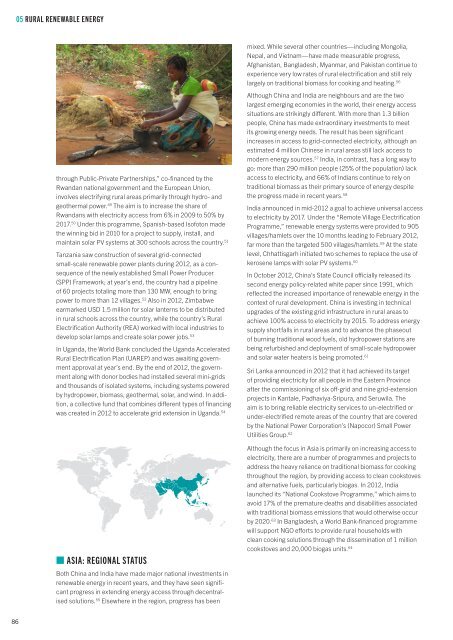RenewableS 2013 GlObal STaTUS RePORT - REN21
RenewableS 2013 GlObal STaTUS RePORT - REN21
RenewableS 2013 GlObal STaTUS RePORT - REN21
You also want an ePaper? Increase the reach of your titles
YUMPU automatically turns print PDFs into web optimized ePapers that Google loves.
05 RURAL RENEWABLE ENERGY<br />
mixed. While several other countries—including Mongolia,<br />
Nepal, and Vietnam—have made measurable progress,<br />
Afghanistan, Bangladesh, Myanmar, and Pakistan continue to<br />
experience very low rates of rural electrification and still rely<br />
largely on traditional biomass for cooking and heating. 56<br />
through Public-Private Partnerships,” co-financed by the<br />
Rwandan national government and the European Union,<br />
involves electrifying rural areas primarily through hydro- and<br />
geothermal power. 49 The aim is to increase the share of<br />
Rwandans with electricity access from 6% in 2009 to 50% by<br />
2017. 50 Under this programme, Spanish-based Isofoton made<br />
the winning bid in 2010 for a project to supply, install, and<br />
maintain solar PV systems at 300 schools across the country. 51<br />
Tanzania saw construction of several grid-connected<br />
small-scale renewable power plants during 2012, as a consequence<br />
of the newly established Small Power Producer<br />
(SPP) Framework; at year’s end, the country had a pipeline<br />
of 60 projects totaling more than 130 MW, enough to bring<br />
power to more than 12 villages. 52 Also in 2012, Zimbabwe<br />
earmarked USD 1.5 million for solar lanterns to be distributed<br />
in rural schools across the country, while the country’s Rural<br />
Electrification Authority (REA) worked with local industries to<br />
develop solar lamps and create solar power jobs. 53<br />
In Uganda, the World Bank concluded the Uganda Accelerated<br />
Rural Electrification Plan (UAREP) and was awaiting government<br />
approval at year’s end. By the end of 2012, the government<br />
along with donor bodies had installed several mini-grids<br />
and thousands of isolated systems, including systems powered<br />
by hydropower, biomass, geothermal, solar, and wind. In addition,<br />
a collective fund that combines different types of financing<br />
was created in 2012 to accelerate grid extension in Uganda. 54<br />
■■Asia: Regional Status<br />
Both China and India have made major national investments in<br />
renewable energy in recent years, and they have seen significant<br />
progress in extending energy access through decentralised<br />
solutions. 55 Elsewhere in the region, progress has been<br />
Although China and India are neighbours and are the two<br />
largest emerging economies in the world, their energy access<br />
situations are strikingly different. With more than 1.3 billion<br />
people, China has made extraordinary investments to meet<br />
its growing energy needs. The result has been significant<br />
increases in access to grid-connected electricity, although an<br />
estimated 4 million Chinese in rural areas still lack access to<br />
modern energy sources. 57 India, in contrast, has a long way to<br />
go: more than 290 million people (25% of the population) lack<br />
access to electricity, and 66% of Indians continue to rely on<br />
traditional biomass as their primary source of energy despite<br />
the progress made in recent years. 58<br />
India announced in mid-2012 a goal to achieve universal access<br />
to electricity by 2017. Under the “Remote Village Electrification<br />
Programme,” renewable energy systems were provided to 905<br />
villages/hamlets over the 10 months leading to February 2012,<br />
far more than the targeted 500 villages/hamlets. 59 At the state<br />
level, Chhattisgarh initiated two schemes to replace the use of<br />
kerosene lamps with solar PV systems. 60<br />
In October 2012, China’s State Council officially released its<br />
second energy policy-related white paper since 1991, which<br />
reflected the increased importance of renewable energy in the<br />
context of rural development. China is investing in technical<br />
upgrades of the existing grid infrastructure in rural areas to<br />
achieve 100% access to electricity by 2015. To address energy<br />
supply shortfalls in rural areas and to advance the phaseout<br />
of burning traditional wood fuels, old hydropower stations are<br />
being refurbished and deployment of small-scale hydropower<br />
and solar water heaters is being promoted. 61<br />
Sri Lanka announced in 2012 that it had achieved its target<br />
of providing electricity for all people in the Eastern Province<br />
after the commissioning of six off-grid and nine grid-extension<br />
projects in Kantale, Padhaviya-Sripura, and Seruwila. The<br />
aim is to bring reliable electricity services to un-electrified or<br />
under-electrified remote areas of the country that are covered<br />
by the National Power Corporation’s (Napocor) Small Power<br />
Utilities Group. 62<br />
Although the focus in Asia is primarily on increasing access to<br />
electricity, there are a number of programmes and projects to<br />
address the heavy reliance on traditional biomass for cooking<br />
throughout the region, by providing access to clean cookstoves<br />
and alternative fuels, particularly biogas. In 2012, India<br />
launched its “National Cookstove Programme,” which aims to<br />
avoid 17% of the premature deaths and disabilities associated<br />
with traditional biomass emissions that would otherwise occur<br />
by 2020. 63 In Bangladesh, a World Bank-financed programme<br />
will support NGO efforts to provide rural households with<br />
clean cooking solutions through the dissemination of 1 million<br />
cookstoves and 20,000 biogas units. 64<br />
86




